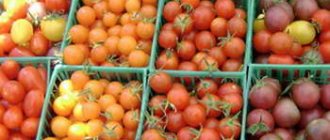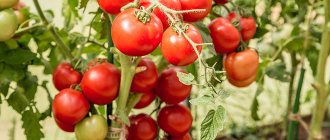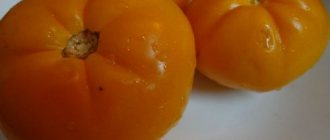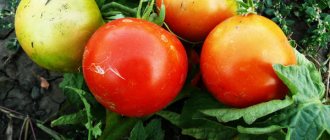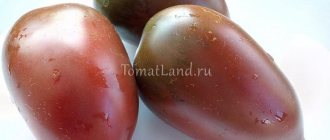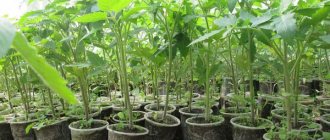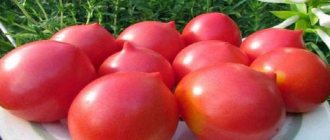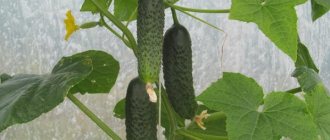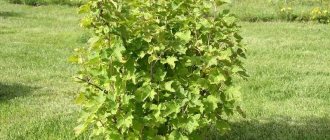Tomato Orange is a new variety. Breeders presented it to farmers in 2000. The cultivar turned out to be competitive, and now it is already popular and in demand in seed stores. The highlight of the variety is its high yield. By planting just a few plants, the gardener will have fresh tomatoes on the table all summer long.
| Height | Landing location | Ripening time | Fruit color | Fruit size | Origin | Fruit shape |
| short | Open ground | Early ripening | Orange | Average | Variety | Flat-round |
Characteristics and description of the variety
The Orange tomato variety is a mid-season hybrid. Its full ripening occurs within 100-110 days from the moment the seeds are planted. The bushes of the plant are neat, moderately spread out and of medium size. Their height, as a rule, does not exceed 80 cm, so they are easy to care for and tomatoes do not need careful tying.
During the flowering period, traditional leaves form on the bushes. The first inflorescences develop between the 5th and 7th leaves, subsequently they form a little higher, every 1-2 leaves.
Tomato leaves are regular, tomato-like, medium-sized and deep green in color. The fruits are characterized by a bright orange hue, round in shape with medium weight, moderately dense and fleshy. Unripe tomatoes are green in color. Their surface is smooth, the peel is of medium density, it protects the tomatoes well from mechanical stress.
Tomato Orange has excellent taste, is resistant to many dangerous diseases, and is not difficult to grow. The yield is quite high. If you follow the care and planting technology correctly, you can get 6.5 kg of vegetables from 1 m2.
Interesting! The weight of an Orange tomato can reach 90-150 grams.
Characteristics of the variety
It is worth noting that the best place for growing Orange tomatoes is a greenhouse shelter. But this does not stop gardeners in the southern regions from planting crops in open ground conditions. You can achieve good results by following simple rules. One of the important points is timely sowing and transplanting of seedlings.
The quality of the soil and the amount of sunlight under which the crop will grow are also important for the Orange variety. The mid-season variety has a short growing season, which averages 100 days. It may take a little longer and take 115 days. It is difficult to call tomato bushes tall. But they are taller than average and spreading.
Orange is classified, according to its characteristics, as super-determinate plants that grow up to 80 cm in height. This plant size becomes ideal for those gardeners who like to grow tomatoes in a greenhouse.
Few leaves are formed on the bushes. As soon as the fifth true leaf is formed, a simple inflorescence appears. The next inflorescence will appear through the next two formed leaves. The stalk of the variety is characterized by articulation and high strength. This characteristic gives the gardener confidence that nothing will prevent the fruits from gaining maximum weight, which on average is 150 grams. But you can hope for results if the crop grows in favorable conditions, a stable warm climate and with regular feeding.
Fruits that have not reached the ripe stage are characterized by a pale green tint. In the place where the fruit is connected to the stalk the shade is dark green. By the time they ripen, you can see the tomatoes turning yellow. Biological maturity leads to a complete change in the color of the fruit to orange, the most saturated, which indicates a high content of a compound called beta-carotene.
Orange tomato fruits, according to the description, contain about 3% carotene, which allows the tomato to be used for preparing dietary products. The fruits are round with a flattened top. The taste of tomatoes is pleasant, without pronounced sourness, a sweet note predominates.
Advantages and disadvantages of the Orange variety
Among the main advantages of the Orange tomato variety are:
- High yield.
- Mid-ripening - it will be possible to harvest the first tomato fruits after 60-65 days from the moment of transplanting the seedlings.
- The fruits of the vegetable have an original color, they contain many vitamins and beta-carotene, and they taste sweetish.
- Resistance to major dangerous diseases.
- Tomato Orange does not require special care and tolerates adverse conditions well.
- Fruit ovaries, as a rule, appear simultaneously and the fruiting of the plant itself is long-lasting.
According to reviews from summer residents, the Orange tomato variety has no disadvantages.
How to grow
- Orange tomato seeds are prepared in advance for sowing, taking into account the reviews of experienced farmers. It is worth counting 6 or 8 weeks from the time of transplantation and carrying out sowing work.
- The grooves for the seeds are made shallow so that it is easy for the plant to hatch. The soil should be well moistened and the soil should be warmed up in advance. You can see the first shoots in a week. If the storage conditions of the container with the sown crop were not ideal, you should wait two weeks until the seedlings appear.
- This is followed by the germination process on the windowsill, where the crop will be warm and light enough for normal development. Gardeners can also grow the plant under lamps, which should be left on for 16 hours a day. At this stage, the plant does not need a lot of fertilizer. The first fertilizing is carried out three weeks from the moment of sowing. A water-soluble universal material is used for these purposes.
- For better transplantation and reducing the stress factor for the crop, it is necessary to harden the seedlings. Place seedlings outside for several hours a day only in places where there is sun and no drafts.
- When planting Orange tomatoes, taking into account recommendations, characteristics and reviews, it is worth adhering to crop rotation so as not to expose the crop to the risk of developing various diseases. Each bush is planted at a distance of 40 cm from the other. It is not worth planting bushes that are bushier, so as not to complicate the care process and not to interfere with the plant’s normal development.
- Experienced gardeners prefer to plant seedlings deep so that the root system can grow better and have a better chance of coping with prolonged drought. The replanting process is completed with thorough irrigation, which helps dislodge air pockets from the soil and allows for faster rooting in the new location. In a month, powerful bushes will need a small but reliable support.
Growing rules
Growing Orange tomatoes is not at all difficult and it is quite possible to get a rich harvest. All you need is to choose the right site for planting, pre-prepare the soil and seeds, transplant the seedlings in a timely manner and carry out proper care. By following these simple recommendations, a rich tomato yield is guaranteed.
Soil preparation
The soil for tomatoes should be prepared in the fall. To do this, carefully dig up the soil and apply the necessary fertilizers. In the spring, just before planting the seedlings, the soil is dug up again and fertilizers are applied again to speed up the growth and development of the tomato.
When choosing a site for planting this vegetable, it is better to choose those places where onions, cabbage or eggplants grew last year. Do not plant where tomatoes, as well as any nightshade crops and corn, were already growing.
The area for Orange tomatoes should be sufficiently illuminated by sunlight, have small screens to protect the plants from the wind, and low areas should be excluded. Because moisture accumulates in them, which can lead to blackleg, rot and other diseases.
To plant Orange tomato seeds, soil can be purchased ready-made or you can make it yourself. To do this, you need to mix the following components, such as peat, wood ash, sawdust and turf soil.
The prepared substrate is laid out in special boxes or plastic containers and the seeds are sown.
Note! The soil for growing Orange tomatoes should be chosen with low acidity or neutral.
Seed preparation
To avoid wasting your time, you need to check them before sowing seeds in the soil. To do this, the seeds are dipped in a glass of water. The specimens that float to the surface are removed, and those that remain at the bottom are used for planting.
After checking, you can use a growth stimulator. It will help speed up the development and germination of seedlings.
Important! To disinfect the seeds, you should soak them in a solution of potassium permanganate for a while.
Sowing tomato seeds
Tomato seeds are sown in pre-prepared containers with substrate. It is moistened, then small furrows are made in the ground and the seeds are laid out. They are covered with soil on top.
Orange tomato sowing is carried out at the end of March or beginning of April, at the rate of 50-60 days before planting seedlings in open ground or a greenhouse.
As the tomato grows, water it if necessary, weed the soil and fertilize the plants.
Note! To plant seeds, it is advisable to choose containers with holes or make them yourself to ensure normal air circulation.
Planting seedlings in the ground
When the seedlings are sufficiently strong and grown, they are planted in a greenhouse or open ground. As a rule, this occurs at the beginning of June, when warm weather has already established itself and there are no night frosts.
Transplantation is also carried out in warm, clear weather. The soil is pre-prepared, it is dug up and the necessary fertilizers are applied. Afterwards, shallow holes are made along the entire perimeter of the site. When digging them, it is necessary to observe intervals, the distance between holes should be 30 cm, and between rows at least 50 cm, so that the plants can develop comfortably and people can take care of them.
Next, you can pour a small amount of wood ash into the holes to disinfect the soil and prevent the occurrence of fungal diseases. The seedlings are immersed in the ground until the root system is hidden, sprinkled with soil on top and lightly compacted.
After planting, the plants are thoroughly watered and given proper care during their growth.
Interesting! To make the bush more powerful, you can use 2-3 seedlings at once when forming it.
Rules of care
Caring for it is simply necessary. It starts from the very beginning of planting seeds until harvesting. To collect good tomato fruits, you need to work hard. To do this, it is recommended to water the tomatoes in a timely manner, carry out weeding, loosening the soil, as well as systematically apply fertilizers and fight diseases and pests.
Orange tomatoes need to be watered as the soil dries out. You should also pay attention to weather conditions. If there are frequent and heavy rains, the seedlings are not watered, and in case of drought, watering can be carried out up to 2 times a day.
Immediately after transplanting a tomato, it should not be watered for several days. This will help avoid blackleg, rot and other diseases. Afterwards water as usual. And more abundant watering should be carried out during the flowering of the bushes and the setting of fruits.
Weed and loosen the soil as needed, usually every 1.5-2 weeks.
Fertilizing is applied about 3 times during the entire growth of the tomato. First, fertilizer is applied 14 days after transplanting the seedlings, then during the flowering period and the last fertilizing is applied when the fruits begin to form. Mineral and organic compounds can act as fertilizers.
When using them, be sure to follow the instructions and apply fertilizer only in clear, warm weather.
Also, during the growth and development of Orange tomatoes, the bushes should be chopped and tied up. For this purpose, the most powerful and developed stems are left; those without ovaries are removed, as are excess leaves. This is necessary for the tomato fruit to grow well. If you do not chop the bushes in a timely manner, all the nutrients and energy of the plant will be spent only on the growth of greenery.
Features of the fruit
4-5 simple unbranched fruit clusters are formed on the plant. Each of them contains 5-6 neat spherical tomatoes with a diameter of about 7 cm and a weight of 120-150 g. The ovaries develop and ripen together. The color of the fruit at technical ripeness is pale green, with a darker area at the base. As the tomatoes ripen, they become bright orange, resembling small oranges in appearance. There are no green areas left on the stalk.
The skin of the fruit is very durable; tomatoes do not crack when ripened and exposed to heat. They are convenient to transport - the durable shell allows the tomatoes to maintain their presentation and not spoil for several days. Unripe Orange tomatoes, picked at technical or blanzhe ripeness, ripen well in room conditions, practically without losing their taste properties and vitamins.
The pulp is orange in color, juicy, quite dense in slightly unripe tomatoes and has a pleasant melon consistency in berries that have reached biological ripeness. The structure of the fruit is reminiscent of beef tomatoes: several small seed chambers are concentrated in the pulp; The fruit is fleshy.
The characteristics and description of the variety note the high sugar content in the tomato pulp and the saturation of beta-carotene. It is this substance that gives color to the peel and pulp of the fruit, as well as valuable qualities. The lycopene content in orange-fruited varieties is as high as in red ones. The reduced allergenicity of lighter varieties of tomatoes makes them suitable for children's and dietary nutrition.
The taste qualities are rated by gardeners as high or excellent. The pulp has a pronounced sweet taste; in cold seasons it acquires a slight piquant sourness. The aroma is classic tomato, not too strong.
See also
Description of the Alenka tomato, growing a hybrid variety and care
Read
The purpose of the bright fruits is to use them fresh. Beautiful slices will make salads and holiday cuts more picturesque; Also suitable for making sandwiches. The pleasant taste of tomatoes allows them to be used for delicious snacks. Tomatoes can also be used for preparing hot dishes that require tomatoes. Sauces and soups containing them will be lighter than usual, but the golden color of the dishes can be an attractive highlight.
Surplus vegetable products can be harvested for the winter using any traditional methods. Small-sized tomatoes are selected for whole-fruit canning. Very ripe and large tomatoes can be processed into thick juice with a pleasant orange hue. It will retain all the beneficial properties of fresh fruits and will appeal to children. An unusual filling for appetizers in tomato will help you get original sauces and lecho.
Diseases and pests
Regardless of the fact that the Orange tomato variety is highly resistant and immune to some major diseases, such a plant can still be exposed to them. Infection especially occurs with poor care and non-compliance with preventive measures.
Quite often among tomatoes of this variety there are black leg, various forms of rot, spotting, mosaic and other diseases. All of them negatively affect the general condition, contribute to the destruction of leaves and the fruits themselves, and if measures are not taken in time, the plant may die.
Among the pests of the Orange tomato, the most common are mole crickets, wireworms, aphids and whiteflies.
Pros and cons of the variety
Of course, every summer resident wants to know about the advantages and disadvantages of the variety that he is going to grow on his plot. The advantages of the Orange tomato, according to the description of the variety, include the following: increased yield, average ripeness - you can enjoy the first fruits already two months after the seedlings are planted in a permanent place. Gardeners also note the taste of the fruit: it is sweetish due to the beta-carotene content. By the way, tomatoes of this variety contain a lot of vitamins. One of the main advantages is resistance to major diseases that affect representatives of the nightshade family, and the uniform appearance of ovaries. It should also be noted that the bushes tolerate unfavorable conditions well. As for the shortcomings, if you believe the reviews, there are simply none.

